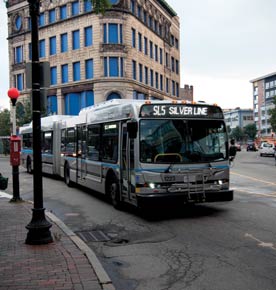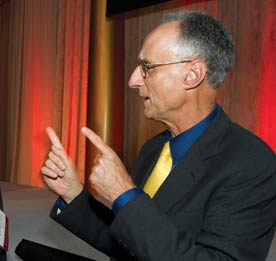It’s About the People
As much as Refund California is about action on the policy level, it’s also about building a popular movement around these incremental policy changes. It is about the people who are fed up with bank abuse and are coming together across the state to do something about it.
Take William and Esperanza Casco, owners of a small market in the city of South Gate. They have raised their three children in their Long Beach home of over 17 years, but in late 2009, despite the fact that they had a stable income from their business and were not having trouble with their payments, they were put into a forbearance plan that significantly reduced their payments and were then encouraged to apply for a HAMP modification. Like so many, they were given a trial modification with lower payments. They continued making on-time payments until August 2010 when JPMorgan Chase told them that they were $50,000 in arrears and put them into foreclosure. On September 12, 2010, even though they never missed a payment on their loan, the Cascos’ home was sold and the family faced eviction.
But rather than give up, the Cascos found the ACCE Home Defenders League. On November 23, 2010, ACCE members held a press conference at the family’s home followed by an action at the nearby Chase Bank branch. Armed with roasted turkey, greens, corn bread, pumpkin pie, and more, we set up a long table, chairs, and tablecloth, and joined the Cascos for their Thanksgiving dinner at Chase Bank — since they would soon have no place else to hold it.
ACCE members kept the pressure on, and by mid-December the Cascos were back in negotiations with Chase. By January, their foreclosure was reversed, a fair modification agreed upon, and they had their home back.
The lesson here is that playing by the rules created by the banks works for Wall Street. Collective direct action works for Main Street.
Home Defenders League has taken the fight to the streets to save someone’s home from foreclosure or demand that the banks pay to clean up their mess at least once a week since the campaign launched. These actions are the fuel that leads to immediate wins, keeps our members motivated, and builds public and political support for the policy demands that hold the promise of helping our communities as a whole over time.
Regular people like Peggy Mears and Donna Vieira are leading the charge. Driven by their conviction that the banks are harming America and the American Dream, they speak to some of the angry millions who are struggling to pay their mortgage, credit cards, or college loans while they watch the banks get away with unconscionable acts of recklessness and fraud that crashed the economy and meant job loss, home loss, and an overall loss of wealth to millions of working- and middle-class families.
“One chopstick breaks easily. Many chopsticks cannot be broken.” Vieira shared this Chinese proverb as she talked about her strong commitment to organizing. Born in China and having lived there until her early 30s, this kind of activism did not come naturally to her. When she and her husband, a real estate appraiser, learned that Wells Fargo was foreclosing on their home, she felt shame. She didn’t want people to know. But all this changed once she understood better what the banks had done. Then she got mad. She found ACCE and PICO, two community groups helping struggling homeowners and the community fight back.
Vieira began participating in community meetings and actions. In April 2011, she joined over 500 people in a march on the annual Wells Fargo shareholders meeting in downtown San Francisco. Armed with shareholder proxies that gave them entry, Vieira and nine others attended the shareholders meeting. They went up to the microphone in pairs, told their foreclosure horror stories, and demanded that CEO John Stumpf agree to renegotiating mortgages based upon a significant reduction in principal, which would prevent tens of thousands of foreclosures. Pair after pair of protestors were escorted out by the San Francisco Police Department. Our group completely took over the meeting and forced the discussion to be about the abhorrent actions of Wells Fargo for nearly an hour, making the shareholders and top bank executives listen to the real life effects of their decisions. In the end, a total of eight people were arrested, and the event received significant positive media coverage that framed the issue as homeowners standing up to Wall Street.
Far from a radical, Vieira sees herself as simply standing up for truth and integrity against the dangerous and criminal abuses of the big banks. As she puts it, “When you see a wrong, you need to speak up. People are just trying to live with some dignity. It’s up to us to fight to preserve homeownership — the American Dream.”
Mears’s story is similar in that when she first got the foreclosure notice she was depressed. But then she got angry. She and her husband Alvin have owned their home for over 20 years and raised two kids there. “The house is nothing fancy, but my husband worked very hard for it. He put his blood, sweat and tears into it,” she says.
After hearing a news report about an ACCE rally organized for a family refusing vacate their home, Mears called up the ACCE Home Defenders League, got involved, and quickly became a leader.
Then in December 2010, Mears, her husband, and 125 struggling homeowners, community residents, and their supporters gathered in downtown Los Angeles for an action at a Chase Bank office tower. They formed a circle in front of the building, and held hands in a prayer. They prayed for strength and prayed that their actions and words would touch the hearts of the bank executives.
The event resulted in a complete shut down of the bank and effectively all the other businesses in the 26-story office building. Roughly 100 police officers were on the scene, as were a dozen press outlets. After the protestors spent an hour singing and chanting and attracting the attention of lunchtime passersby, the police arrested all of them and walked them, one by one, to a waiting paddy wagon.
Mears is proud of this moment. “Even though we were fighting a mighty bank, it’s like the story of David and Goliath. I felt like David on that day.”






Comments